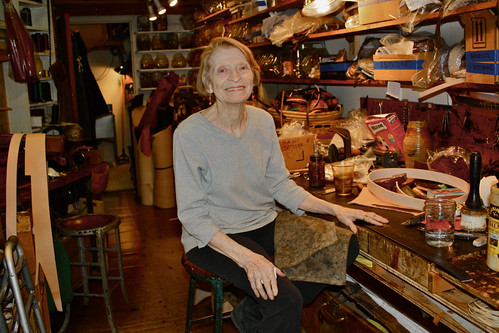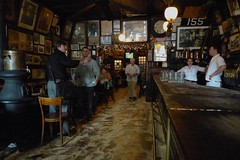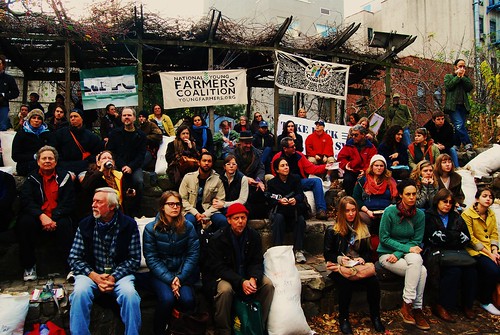 Suzanne RozdebaBarbara Shaum in her workspace on East 4th Street.
Suzanne RozdebaBarbara Shaum in her workspace on East 4th Street.When you’ve been in business as a ‘solopreneur’ since 1962, you find you’re known for a few things, and you pay no mind about taking your time to relay all the details to anyone within earshot. For Barbara Shaum, 80-something, the legend behind the institution that is Barbara Shaum Ltd. on 60 East 4th Street, that means noting she was the very first woman officially to enter the male-only McSorley’s Bar, and that she hand-makes what fashion icons view to be some of the very best leather sandals and belts in the city. These days, it is rarity to enter a shop where there is a craftswoman who cobbles the very item you plan to slip on, right there in the store. Ms. Shaum, but she doesn’t have plans to retire either. Too many people are depending on her to outfit their feet.
Q.
How did you make your way into this business?
A.
I was doing wholesale and living in a loft on West Broadway. I was working for a wonderful sandal-maker who taught me so much of what I know. This was back in the 50s. Then I went on my own in 1962, opening up a shop on 7th Street between Bowery and Second Avenue.
Q.
Right next to McSorleys! That must have been interesting.
A.
Absolutely. It was for men only until 1970 when the Civil Rights Bill was passed and they could no long discriminate against women patronizing their establishment. I was the first woman in there and that’s the kind of person I am.
Q.
Was there a benefit to being in the location next to such a legendary place?
A.
I sell to men and women and the bar was enormously popular. It was the 60s so there were hippies wearing a lot of belts and sandals so I was making a lot of sandals and belts. That was a good time for me. Lots of off-beat people with style.
Q.
People weren’t really worrying about making their rent so much then were they?
A.
In those days things were not so much focused on real estate and money and that sort of thing. My rent was very low. It was $75 a month for quite a large place. I had a front part and a back part where I put up a wall and I lived back there. I also had a backyard and I’d have these big backyard barbecues with like 75 people coming by. Read more…
 Pat Merino Another day of drinking at McSorley’s.
Pat Merino Another day of drinking at McSorley’s.One of the neighborhood’s most famous landmarks has joined the chorus for an historic district in the neighborhood.
In the past, the owner of McSorley’s Old Ale House was wary of any regulation of renovations to their building at 15 East Seventh Street. But now they would rather be included in the 330 buildings that comprise the proposed East Village-Lower East Side Historic District.
“We’ve surrendered to it, it’s time,” said Bill Wander, an unofficial historian of the bar who is close to its owner. “Now that the rest of the neighborhood is going to be protected, let’s not be left out.”
McSorley’s embraces its history as much as any business in the East Village. In February, for example, the McSorley’s Militia celebrated its 158th anniversary with a five-gun salute in Revolutionary War garb. Still, bar owner Matthew Maher had been skeptical of the designation for the typical reasons — the approval process involved in replacing things like windows and air conditioning units.
Read more…
Photos: Scott Lynch
After celebrating early with the Hells Angels in the wilds of Queens, The Local spent St. Patrick’s Day proper in – where else? – the East Village. Of course we knew better than to look for green in the bars where Irish eyes weren’t exactly smiling on it; instead we had photographer Scott Lynch rove the streets near McSorley’s, Webster Hall, Penny Farthing, Village Pourhouse, Bull McCabes and other destinations. That’s right: he left the apartment on Saturday so you didn’t have to. If you did venture out, let us know how it went for you.
While East Ninth Street warped back to the 1960s (see The Local’s Flickr page for photos of today’s “Inside Llewyn Davis” action, including some shots of the Coens brothers at work), East Seventh Street traveled even further back in time today, as men in Revolutionary War regalia fired muskets into the air.
The five armed and costumed soldiers were members of McSorley’s Militia, who muster themselves each year for the anniversary of the founding of McSorley’s Old Ale House.
Shane Buggy, a 24-year-old bartender at the storied saloon, said, “Today is our 158th Anniversary: 17th of February every year. It’s the only day we have music in the bar so all the regulars come from near and far to check out the activities.” Mr. Buggy, who is Irish, added, “I’ve actually got people that come here from Ireland just to see this anniversary.”
One of the regulars waiting in line to get inside the bar was Brad Lauster, 36, an IT entrepreneur. Asked why he came to the pub today, he said, “I was probably here for the first time 15 years ago, just with a friend who lived in New York City at the time, and so now I live in Brooklyn and we were walking by and it’s the anniversary.”
 Tim Schreier
Tim SchreierGood morning, East Village.
The above photo is from the Occupy Wall Street Farmers March from the La Plaza Cultural community garden to Zuccotti Park. You can see more of Tim Schreier’s photos here. On Sunday, about 250 participants (by EV Grieve’s estimate) marched to promote “dialogue, solidarity and solutions to corporate control of our food system,” according to a flyer.
The Times reports that Billy’s Antiques, the tent near the corner of Bowery and Houston that has been stocked with oddities and ephemera since 1986, will close so that its landlord can start construction on a two-story building. Billy Leroy, the tent’s “Barnumesque” owner, will be allowed to reopen in the new building, but a member of his staff considers the closure “part of that final transition to a landscape of Pottery Barns and Starbucks.”
EV Grieve notices candles outside of Joe’s Bar commemorating the recent death of its owner. Read more…






